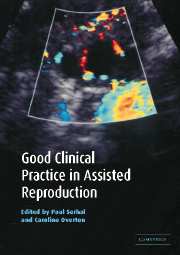Book contents
- Frontmatter
- Contents
- List of contributors
- Foreword by Bob Edwards
- Preface
- 1 Clinical assessment of the woman for assisted conception
- 2 Clinical assessment and management of the infertile man
- 3 Laboratory assessment of the infertile man
- 4 Donor insemination
- 5 Treatment options prior to IVF
- 6 Strategies for superovulation for IVF
- 7 Techniques for IVF
- 8 Ovarian hyperstimulation syndrome
- 9 Early pregnancy complications after assisted reproductive technology
- 10 Oocyte donation
- 11 Surrogacy
- 12 Clinical aspects of preimplantation genetic diagnosis
- 13 Controversial issues in assisted reproduction
- 14 Alternatives to in vitro fertilization: gamete intrafallopian transfer and zygote intrafallopian transfer
- 15 Counselling
- 16 Good nursing practice in assisted conception
- 17 Setting up an IVF unit
- 18 Information technology aspects of assisted conception
- 19 Assisted reproductive technology and older women
- 20 Ethical aspects of controversies in assisted reproductive technology
- Index
- Plate section
4 - Donor insemination
Published online by Cambridge University Press: 22 October 2009
- Frontmatter
- Contents
- List of contributors
- Foreword by Bob Edwards
- Preface
- 1 Clinical assessment of the woman for assisted conception
- 2 Clinical assessment and management of the infertile man
- 3 Laboratory assessment of the infertile man
- 4 Donor insemination
- 5 Treatment options prior to IVF
- 6 Strategies for superovulation for IVF
- 7 Techniques for IVF
- 8 Ovarian hyperstimulation syndrome
- 9 Early pregnancy complications after assisted reproductive technology
- 10 Oocyte donation
- 11 Surrogacy
- 12 Clinical aspects of preimplantation genetic diagnosis
- 13 Controversial issues in assisted reproduction
- 14 Alternatives to in vitro fertilization: gamete intrafallopian transfer and zygote intrafallopian transfer
- 15 Counselling
- 16 Good nursing practice in assisted conception
- 17 Setting up an IVF unit
- 18 Information technology aspects of assisted conception
- 19 Assisted reproductive technology and older women
- 20 Ethical aspects of controversies in assisted reproductive technology
- Index
- Plate section
Summary
Following the establishment of intracytoplasmic sperm injection (ICSI), the number of donor insemination (DI) treatment cycles performed in the UK has dramatically reduced from 25 623 cycles in 1992/93 to 11 035 in 1998/99 (Human Fertilisation and Embryology Authority, 2000) with an accompanying increased live birth rate (LBR) from median 5% in 1992/93 to 9.9% in 1998/99. Therefore, DI remains a significant fertility treatment option and is likely to remain so until new methods of treating male infertility without recourse to assisted conception are developed. Ideally, all DI centres in the UK should be able to achieve a minimal LBR of 10% but we should continually strive to improve the service to our patients if we are to meet our expectation of improved success rates.
Following the establishment of the Human Fertilisation and Embryology Authority (HFEA), DI has faced many challenges. In this chapter we focus on these challenges and outline methods and lines of investigation that can be used to improve the treatment provided to patients.
Donor recruitment
In the UK, strict adherence to guidelines laid down by the HFEA (www.hfea.gov.uk) has made the recruitment of sperm donors an arduous task. The HFEA strongly recommends that donors should be recruited from a stable heterosexual relationship, preferably with a family of their own, along the lines of the French Centre d'Etude et de Conservation du Sperme Humain (CECOS) system, and that donors provide samples virtually gratis, with a low nominated maximum compensation for their time and travel. Only 10 pregnancies per donor are allowed and until recently, multiple pregnancies counted toward this total.
Keywords
- Type
- Chapter
- Information
- Good Clinical Practice in Assisted Reproduction , pp. 86 - 99Publisher: Cambridge University PressPrint publication year: 2004
- 1
- Cited by

